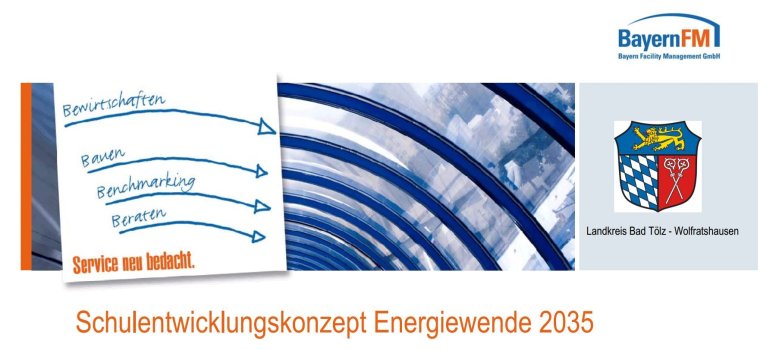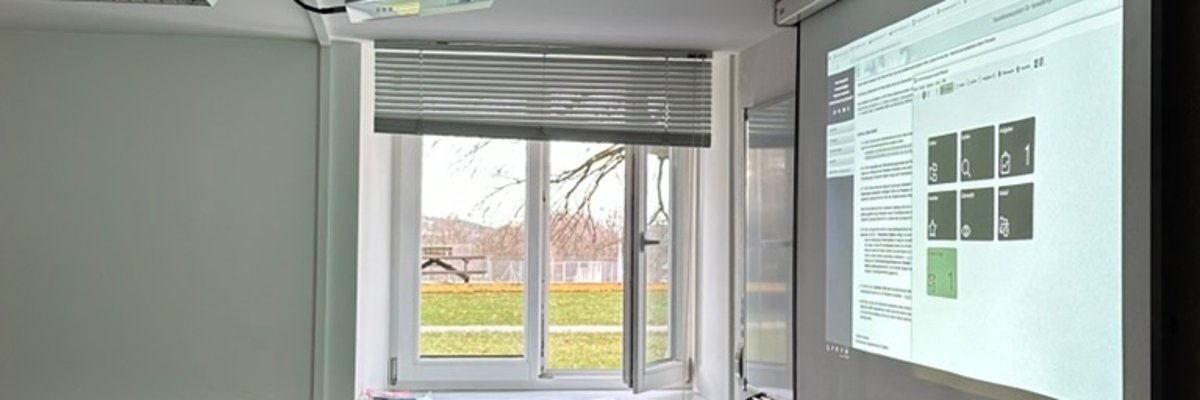Projects in public institutions in the district
The school development concept covers not only the schools, but also other properties in the district. In total, almost 100,000 square meters of floor space were considered in order to be able to make trend-setting decisions with regard to the energy transition in 2035.

Projects funded by the Federal Ministry for Economic Affairs and Climate Protection:
Retrofitting stationary ventilation and air conditioning systems in the secondary school and grammar school in Geretsried
 © BmWK
© BmWKThe Bad Tölz-Wolfratshausen district administration office, as the school's expenditure provider, is retrofitting mechanical ventilation in the classrooms of the interim building and the Musenbau building by the end of April 2023. The district of Bad Tölz-Wolfratshausen will receive a grant from the Federal Office of Economics and Export Control for this.
The 37 classrooms in the interim building and the Musenbau (basement to 1st floor) will be equipped with mechanical ventilation to ensure hygienic air exchange. The agreed air volume flow per pupil/person is 25 m³/h in accordance with the specifications of the Federal Office of Economics and Export Control ("Technical information sheet on the funding guideline", version 4.0 dated 10.09.2021). In the variant pursued from the preliminary design planning, each of the 37
classrooms is equipped with a decentralized ventilation unit so that the structural intervention is kept as low as possible. The use of ceiling units means that as little or no usable classroom space as possible is lost. The outside air is drawn in and the exhaust air is blown out via the facade of the respective classroom. The decentralized ventilation units contain an enthalpy heat exchanger, which can recover both heat and moisture. Should condensation nevertheless occur under the most unfavorable air conditions (only in extremely cold weather), this is removed via the exhaust air outlet. The design of the heat recovery system takes into account sufficient efficiency to meet the requirements of the Ecodesign Directive.Retrofitting of stationary ventilation and air conditioning systems at the Gabriel-von-Seidl Gymnasium in Bad Tölz
 © BmWK
© BmWKThe Bad Tölz-Wolfratshausen district office, as the school's expenditure provider, is retrofitting mechanical ventilation in the classrooms and canteen area at Bad Tölz secondary school by the end of April 2023. The district of Bad Tölz-Wolfratshausen is receiving a grant from the Federal Office of Economics and Export Control for this.
18 classrooms and the canteen area in Building B will be equipped with mechanical ventilation to ensure hygienic air exchange. The agreed air volume flow per pupil/person is 25 m³/h in accordance with the specifications of the Federal Office of Economics and Export Control. The decentralized ventilation units contain an enthalpy heat exchanger, which can recover both heat and moisture.
Retrofitting of stationary ventilation and air conditioning systems as part of the general refurbishment of Wolfratshausen secondary school
 © BmWK
© BmWKThe Bad Tölz-Wolfratshausen district administration office, as the school's expenditure provider, is retrofitting mechanical ventilation in the gymnasium and in the three specialist workshops by the end of June 2023. The district of Bad Tölz-Wolfratshausen will receive a grant from the Federal Office of Economics and Export Control for this.
The three workrooms and the gymnasium will be equipped with mechanical ventilation to ensure hygienic air exchange. The agreed air volume flow per pupil/person is 25 m³/h in accordance with the specifications of the Federal Office of Economics and Export Control. A central ventilation system is installed in the gymnasium. Decentralized ventilation units will be used for the three craft rooms and the changing rooms in the gymnasium. The decentralized ventilation units contain an enthalpy heat exchanger, which can recover moisture as well as heat.
Other funded projects:
Refurbishment of classroom and corridor lighting at Geretsried school center
Initial situation
The existing lighting is largely outdated, is uncontrolled and will be adapted as part of the general refurbishment. Construction phase 2 is currently being implemented, to be followed directly by construction phase 3.Objective
We expect the replacement of the lighting fixtures to result in significant CO² and energy savings. We expect the measure to result in annual electricity savings of around 43,000 kWh for sections 2 and 3 and a corresponding reduction in CO2 emissions of 506 tons over the lifetime of the building.Approach and results
The measures are intended to enable us to collect empirical data on the use of LED technologies for our properties and to deepen and verify the existing findings. We plan to use the knowledge gained systematically for further measures in new construction and refurbishment.Description of the measures
The lighting fixtures have already been replaced as part of the gutting of the existing building in construction phase 2. Depending on the completion of other trades, the new cabling, luminaire installation and commissioning will be carried out successively. This is also planned for construction phase 3.
Involvement of stakeholders
Users are informed about the work and the energy considerations via recurring meetings. The overall project was presented to the district committees and will also be included in the energy report via environmental controlling. A target/actual comparison and a before/after analysis are planned.Retrofitting of decentralized ventilation and air conditioning units at Bad Tölz secondary school
Initial situation
A partial general refurbishment is being carried out at Bad Tölz secondary school. As part of the energy upgrade of the façade, 28 decentralized ventilation units with heat recovery are also planned. The aim is to achieve an optimized energy balance by reducing the ventilation losses caused by the previous window ventilation and improving the indoor air quality at the same time.National Climate Protection Initiative
Since 2008, the Federal Ministry for the Environment, Nature Conservation and Nuclear Safety has been initiating and funding numerous projects that contribute to reducing greenhouse gas emissions through the National Climate Protection Initiative. Its programs and projects cover a broad spectrum of climate protection activities: From the development of long-term strategies to concrete assistance and intensive support measures. This diversity is a guarantee for good ideas. The National Climate Initiative helps to anchor climate protection on the ground. It benefits consumers as well as companies, local authorities and educational institutions.Objective
By retrofitting the systems, we expect a reduction in heating energy consumption and an improvement in indoor air quality. Room-by-room, CO2-dependent control of the ventilation units is intended to achieve needs-based ventilation with optimized energy consumption. A heat recovery coefficient of 0.77 should result in significant energy savings in the overall balance and thus a reduction in CO2 emissions.Approach and results
The measures are intended to enable us to collect empirical data on the use of decentralized ventilation units with modern heat recovery for our properties. We plan to use the knowledge gained for further measures, particularly in the area of refurbishment.Description of the measures
The decentralized ventilation units with heat recovery will be retrofitted as part of the partial general refurbishment.Involvement of stakeholders
Users are informed about the work and the energy considerations via recurring meetings. The overall project was presented to the district committees and will be used repeatedly as a reference project in the future.Gymnasium lighting at Wolfratshausen secondary school
The lighting in the gymnasium dates back to the time of its construction in 1982. The HQL lamps illuminate the entire hall area.
By replacing the lighting fixtures with modern LED technology, considerable CO² and energy savings have been achieved. Over 50,000 kWh can be saved annually and the district administration expects to save more than 600 tons of CO² over the lifetime of the building.
The measure enables us to collect empirical data on the use of LED technologies for our properties. We will use the knowledge gained for further measures in new buildings and refurbishments.
The existing installed light points were reused so that no further electrical installation work was required.
Users were informed about the work and the energy considerations via recurring meetings. The overall project was presented to the relevant district committees and was repeatedly used as a reference object in the further course of the project.Partial renovation of the sports hall at Rainer Maria Rilke Gymnasium Icking
Initial situation
The existing light sources are largely outdated, are uncontrolled and will be adapted in the course of the general refurbishment.
Objective
We expect the replacement of the lighting fixtures to result in considerable CO² and energy savings. We expect the measure to save around 43,000 kWh of electricity per year and a corresponding reduction in CO2 emissions of 340 tons over its lifetime.
Approach and results
The measures are intended to enable us to collect empirical data on the use of LED technologies for our properties and to deepen and verify the existing findings. We plan to systematically incorporate the knowledge gained into further measures in order to use it in new construction and refurbishment projects.
Description of the measures
The lighting fixtures have already been replaced as part of the gutting of the existing building. Depending on the completion of other trades, the new cabling, luminaire installation and presence and daylight-controlled commissioning were carried out successively.
Involvement of stakeholders
Users are informed about the work and the energy considerations via recurring meetings. The overall project was presented to the district committees and is also included in the energy report via the environmental controlling department.
